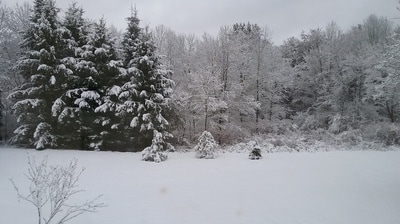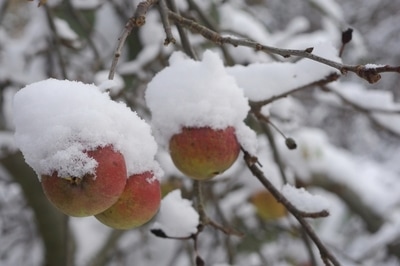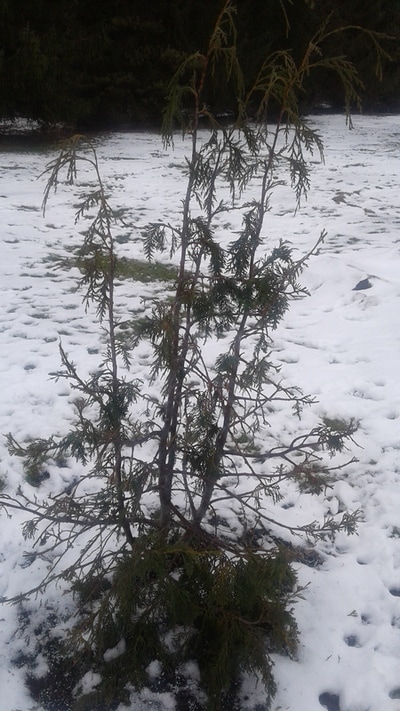|
Winter is a time when significant damage can occur to landscape plants. I'm talking about deer causing damage and even death to your landscape plants. Deer can consume 6 to 8 pounds per day and can cause damage as much 6 feet high.
My inspiration for this blog: We have quite a few deer that roam our property and enjoy eating from our fruit trees and feeding on our grass (Well we do have some pretty great grass here at Cents-Able Solutions LLC). These deer recently consumed a half a dozen pumpkins that we had discarded along the edge of the woods. We noticed the pumpkins where gone overnight. Then a few days later I realized they had found a new snack. Our cute friendly deer family that sought refuge on our land for many years had suddenly turned against us! They had fed upon our landscaping plants. I first noticed a five foot Hetzi Juniper right next to the house was showing signs of damage. The next day a weeping Alskan Cypress, that I had been growing for many years, had been stripped to the point of it looking like a Charlie Brown Christmas tree. This tree, that can grow as tall as 80 feet tall, may now be so injured that it can not recover. Deer damage should be expected and is common in our area. It can be minimized, or even prevented. WAYS TO PREVENT DEER DAMAGE: Planning to minimize damage 1. If it is an option before planting choose an area that has as much open space as possible between the wooded edges of the forest and your landscape. 2. Plant things that the Deer do not like to eat. Choose plants like boxwood, birch, and colorado blue spruce. These plants are generally left alone by deer. If the winter is harsh enough deer can start to munch on the alleged deer resistant species of shrubs, along with eating the bark off twigs and causing extensive damage. Remeber that Hetzi Juniper planted right next to the house. That is considered an 8 on the deer resistant scale of 1 to 10. Ten being the most deer resistant species. So even the best planning cannot guarantee that the deer will leave your plants alone. Repellants 1. Contact repellants- these products are applied directly to the plant to make it taste bad. This can be the most effective type of repellant. Choose the right product and it only needs to be applied once each winter. 2. Area repellants- make the area smell bad. Area repellents are placed in a problem area and repel by their foul odor. The effectiveness can depend on how often it is applied. Generally these products must be used in the Fall and reapplied through out the winter. 3. Home-remedy deer repellents are questionable at best. These may include bags of human hair, or bar soap grated around the area, among others. I have not found any of these to be a en effective deterrent to a hungry deer. Remember deer also carry ticks which can carry lyme disease. This may be another reason that you would want to deter deer from nearby your home. Fencing To successfully protect your landscaping from unwanted pests you can erect a fence. Keep in mind that deer can jump as high as 8 feet, so choose a fence that is at least this tall. The biggest draw back to fencing is the time and effort that it takes to put up and take down. Once it is down for the spring and summer you will need a place to store it. Burlap Wrapping your evergreens in burlap has been an effective way to protect them from winter damage caused by winds and freezing. This can also be an affective deterent to the deer if you only have smaller plants that you want to protect. That weeping alaskan cypress had been wrapped in burlap for the past few winters to protect it. This year I felt it was established enough to withstand the elements. Wrapping it could be what prevented any deer damage in the past. If you only have smaller shrubs to protect, you may want to simply wrap them in burlap. Not only does this protect them from grazing deer, but it protects the shrubs from drying out in the cold winter winds. Inspect your landscaping for signs of deer damage. Remove food sources such as bird feeders, and remember those discarded jack o lanterns? Maybe start a repellant program today, and even sign up with us to get your property treated to protect against ticks in the spring. The deer are hungry. Snow cover on the ground and factors like a low apple crop this year could mean more deer damage than previous years. Comments are closed.
|
AuthorAdam is the Operating Manager at Cents- Able Solutions, LLC. Archives
January 2017
Categories |
Proudly powered by Weebly








 RSS Feed
RSS Feed